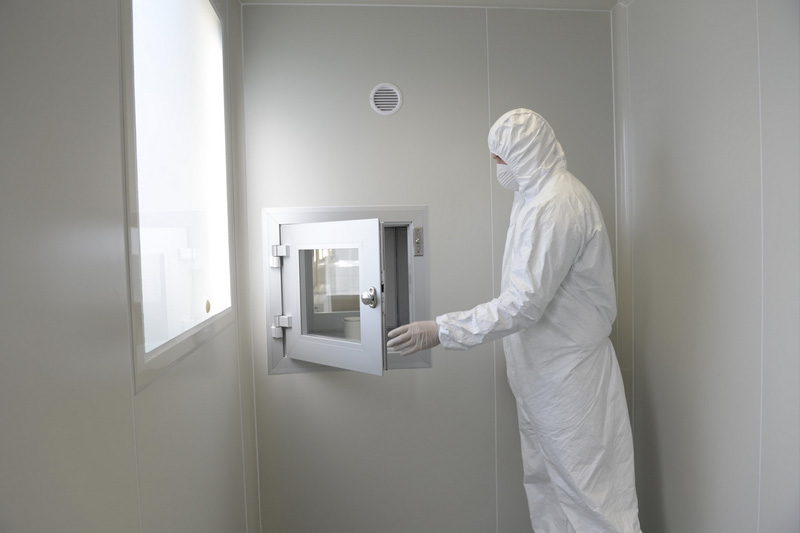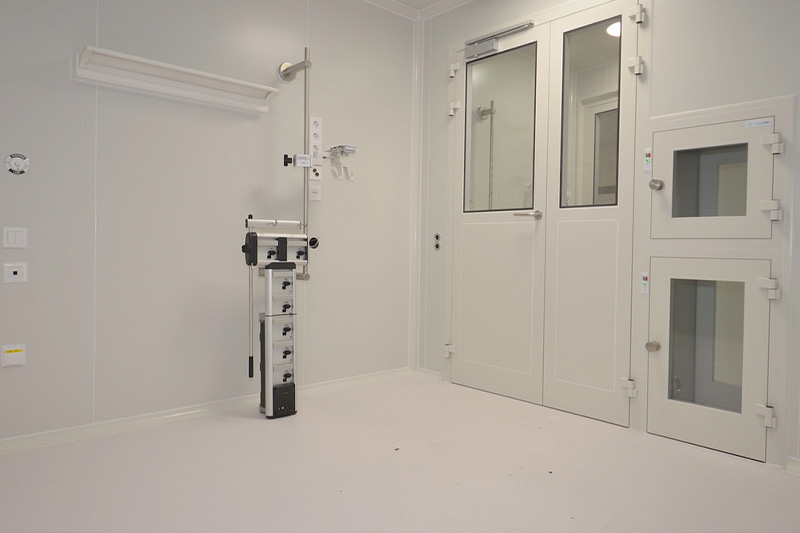KleanLabs has been involved in the establishment of cleanrooms since 2015. They work with hundreds of customers who constantly evaluate their products. Their engineers use this feedback and work with it to keep enhancing the products. In this article, they share their experience on when it is advisable to replace a HEPA filter to ensure the cleanliness of cleanrooms and cleanroom pass boxes without unnecessarily increasing operational costs.
Clean and Sterile Rooms
First of all, cleanrooms are strictly controlled indoor environments where the number of airborne particles and contaminants, temperature, humidity, and pressure are all regulated by predefined standards, including the count of micron and sub-micron sized particles.
In practice, the air entering the clean environment is filtered and monitored according to these parameters using an air handling unit equipped with HEPA filters.
Sterile environments go a step further, being completely free of bacteria and microorganisms. Sterile manufacturing is typically required for very specific tasks, such as vaccine filling.
HEPA Filters and Their Applications
To ensure the proper operation of cleanrooms, the use of special HEPA filters is necessary. HEPA air filters are particularly important because they are incredibly effective at capturing particles of almost all sizes.
These air filters are made either from plastic (PP + PET) or fiberglass and can capture
- viruses,
- bacteria,
- pollen,
- PM2.5 particles,
- allergens,
and are highly effective at capturing nanoparticles as well.
Filters containing activated carbon or catalyst can remove odors and gaseous pollutants, such as volatile organic compounds or ozone. HEPA filters are also the most important components of all air purifiers.
Regulations for HEPA Filters
HEPA filters must meet strict requirements. In Europe, HEPA filters must remove 99.95% of particles (ISO), while in the United States, they must remove 99.97% of particles that are 0.3 μm or larger.
Filters that capture more than 85% but less than 99.95% of particles are called EPA filters or efficient particulate air filters. These air filters do not meet the filtration requirements of HEPA filters. Conversely, filters that exceed HEPA requirements and capture more than 99.999% of particles are called ULPA filters or ultra-low penetration air filters. These are more expensive due to their higher efficiency and moderate resistance levels
To protect HEPA filters, pre-filters are used: typically fine particle filters such as F7 and F9 filters (EN779). These need to be replaced regularly and protect the HEPA filters from clogging.
The cleanliness class of the cleanroom can also affect the filter's lifespan, as more "contaminated" environments place a greater load on the filters.
How often should I change HEPA filters?
The integrity of HEPA filters is essential to ensuring the required cleanliness level for both cleanrooms and pass boxes. However, other relevant aspects should be considered when determining the filter replacement frequency.
These include filter load and pressure drop. If the pressure drop becomes too high, the ventilation system will operate at higher speeds to maintain the required air exchange rates, resulting in higher energy demands. If increased operating costs are observed, it may be worth replacing the HEPA filters
The integrity of HEPA filters is essential to ensure the required cleanliness level of a cleanroom and pass boxes.

The integrity of HEPA filters is essential to ensure the required cleanliness level of a cleanroom and pass boxes
GMP and ISO guidelines
The maximum lifespan of HEPA filters is not specified by GMP and ISO guidelines. However, both GMP and ISO 14644-3 guidelines mandate leak tests at least every 6-12 months.
According to GMP, the filter must be leak-free. Leak tests must be conducted every six months in ISO 1-5 zones and annually in ISO 6-9 environments. Naturally, if the filter fails the test, it must be replaced.
Practical Replacement of HEPA Filters
Determine how contaminated the cleanroom is. The recommended replacement frequency of HEPA filters largely depends on the contamination level of the cleanroom.
For example, ISO 8 cleanrooms do not require changing rooms, so they are much more contaminated than ISO 5 rooms, as they are the least clean in terms of cleanliness classification. The filter load will also be higher in an ISO 8 cleanroom than in an ISO 5 environment. In some cleanrooms, this extra load may result in HEPA filters needing to be replaced annually.
Also, keep in mind that increased filter load can lead to higher energy demands, as the ventilation system needs to work at higher speeds to compensate.
General Replacement Rule
Some companies swear by replacing HEPA filters every three years. The maximum lifespan of HEPA filters, as reported by our clients, is about eight years, which does not mean they have reached their maximum lifespan. As long as the filters are regularly checked and prove to be efficient, they do not need to be replaced.
Extend the Life of Your Filter
Factors affecting filter lifespan include
- Factors affecting filter lifespan include:
- the amount and contamination of filtered external air,
- the amount of filtered recirculated air,
- the frequency and duration of aerosol challenge exposure,
- the effectiveness of pre-filtration methods applied.
Keep in mind that if your filters are custom-made, delivery might take longer after placing the order and come with higher costs. Therefore, regular inspections and preventive measures will be worthwhile in the long run.
In recent years, the manufacturing industry has shifted from preventive maintenance to condition-based maintenance (CBM). Numerous sensors monitor the condition of various components, and maintenance is only performed when certain indicators show performance decline or failure. This technology allows air filters to be used optimally.
Tracking Replacements
The person replacing the filter should always sign and date the filter for a clear workflow. This way, if someone new handles the replacements, they will have full access to the data in a very transparent manner.

Cleanroom operators are increasingly moving from preventive maintenance to more economical condition-based maintenance
Testing the HEPA Filter System
Testing the performance of air filter systems in clean areas is critical to maintaining the cleanliness of the manufacturing environment.
The Dispersed Oil Particulate (DOP) scan test, also known as the filter integrity test or leak test, is one of the most common methods according to industrial standards. The test should be repeated at regular intervals to ensure the continuous efficiency of the filter. During the test, the filter is subjected to an aerosol challenge, meaning particles are introduced into the air, and the output is measured.
Spatial Uniformity of Aerosol Challenge
For accurate filter leak testing, the aerosol concentration must be uniform across the entire upper surface of the tested filter(s). In other words, the aerosol test must have spatial uniformity.
Otherwise, high or low local concentrations may incorrectly result in a failed or successful test. The ISO 14644-3 guideline recommends that the temporal variation of the test aerosol concentration should not exceed ±15%.
Testing Leaks Between the Filter Frame and Housing
A gap exists between the filter frame and the housing. When testing the leak between the filter frame and the housing seal, the probe is placed into this area, and the area is scanned to determine local collection efficiencies.
Based on these measurements, the leakage rate and the total efficiency of the filter, known as the integral value, are calculated. If a leak is found in the filter, it can be repaired using a patching procedure.
If you have any questions
While this article has tried to cover all issues related to HEPA filter replacement, there are certainly individual cases. If you have any further questions, please contact the experts at KleanLabs, who will share a decade of experience and help you with even specific issues.

